Virginia Peregrine Falcon 2014 Update
Evaluating the Supply Side of Bird Migration within a Fall Staging Site
January 13, 2015
Grace In Great Dismal Swamp, Suffolk, VA 1/12/2015
January 14, 2015
Virginia’s Peregrine Falcon population continued to thrive in 2014 with 27 known breeding pairs producing 44 chicks. Virginia’s falcon population is predominantly on the coastal plain with 24 breeding pairs on the coast including 10 peregrine towers, 1 ground nest, 8 bridges, 1 Coast Guard navigation tower, 2 fishing shacks, 1 power plant stack, and 1 high-rise building. The population in the western part of the state remains small with only 3 pairs nesting on rock cliffs. The stronghold of the Virginia population continues to nest on man-made structures requiring regular maintenance and management from The Center for Conservation Biology (CCB) and the project’s many conservation partners.
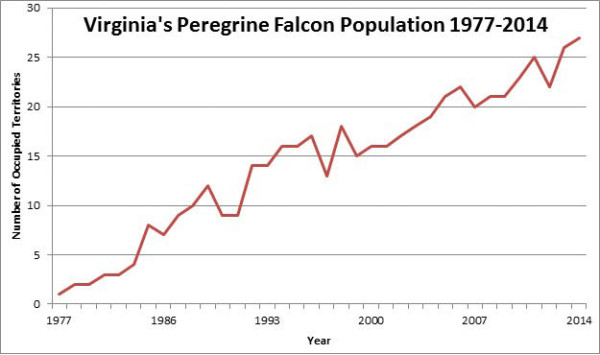
Breeding peregrine falcons in Virginia from 1977-2014. Data from CCB.
The Peregrine Falcon was extirpated as a breeding species in Virginia by the 1960s in part because of nesting failures related to DDT. Many decades of reintroduction efforts by CCB, Cornell University, Virginia Department of Game and Inland Fisheries (VDGIF), and the National Park Service, have brought the breeding population back to pre-DDT levels. The Peregrine Falcon is listed as a threatened species in Virginia and continues to struggle with low fledging survival from bridge nests and threats from new emerging contaminants.
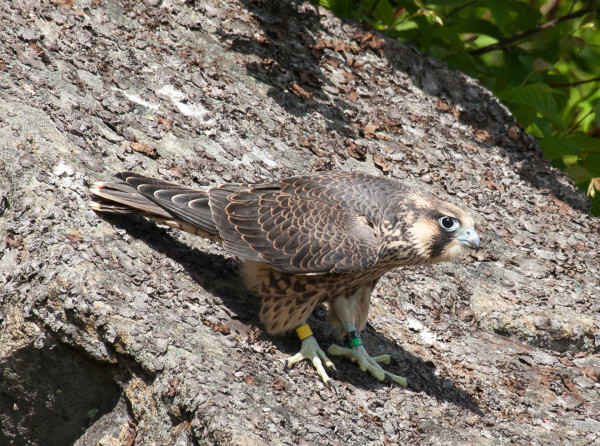
Juvenile Peregrine Falcon from the Berkley Bridge recently released from the hack box at Shenandoah National Park. Photo by Bryan Watts.
In 2014, the Virginia Department of Transportation (VDOT) managed disturbance buffers for 5 occupied falcon nests and coordinated extraction of the chicks for hacking. This effort required close coordination with VDOT bridge, traffic, and environmental staff to pull off accessing the nests with minimal impact to vehicle and boat traffic. The CCB continues to lead a 15-year partnership with Shenandoah National Park, VDGIF, and VDOT to translocate falcon chicks from bridges to the mountains to increase survival rates. Shenandoah biologists and interns released 9 falcons at Hogback Mountain through the hacking program, furthering reintroduction of falcons back into the Virginia mountains.
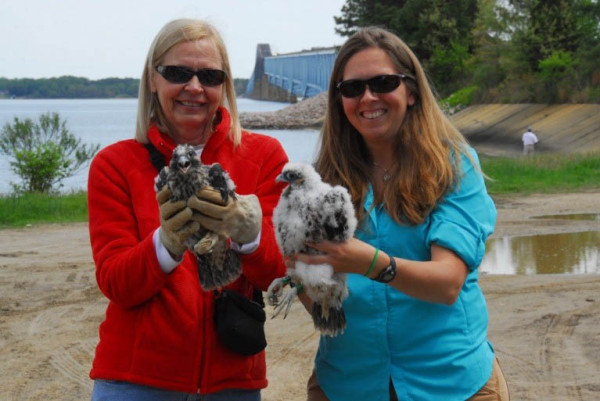
Teresa Tabulenas (VDOT, left) and Libby Mojica (CCB, right) banded two falcon chicks they extracted from the Norris Bridge. Photo Tom Chillemi, Sentinel.

The VDOT bridge team coordinated accessing the falcon nest on the Berkley Bridge on I-264 in Norfolk. From left to right: Robert Hewitt, Tom Mansfield, Dave Kurtich, Kip Holloway. Photo by Libby Mojica.
We continued our band resighting program for adult falcons using a digital game camera mounted at the entrance of the nest box. Fourteen breeding adults were identified, including 4 from New Jersey and 1 from New York. One of our newest pairs at the Silver Beach Range Tower is a mix of origins, with the female from Sea Isle city, NJ (212 km away), and the male from Gull Marsh, VA (19 km away). Often we have to review hundreds of images from the game camera to read the alphanumerics on the bands, piecing together the identity of the bird one image at a time.
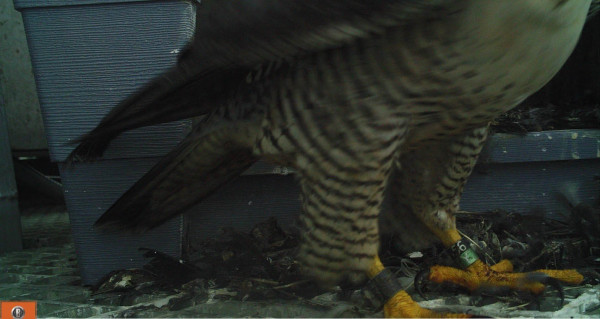
The adult female at the Silver Beach Range Tower nest was identified with a game camera mounted at the nest entrance. The black band on her right leg indicates she’s from New Jersey and the black 56 over green Y provided us with her unique band code. Photo by CCB.
For the second year in a row, a pair of falcons nested on the ground on a sand dune on a barrier island. This is a rare occurrence and noteworthy for the species in our part of the species’ range. Unfortunately the pair was unsuccessful this year because of extreme heat and no shade protection for the nest and nestlings.
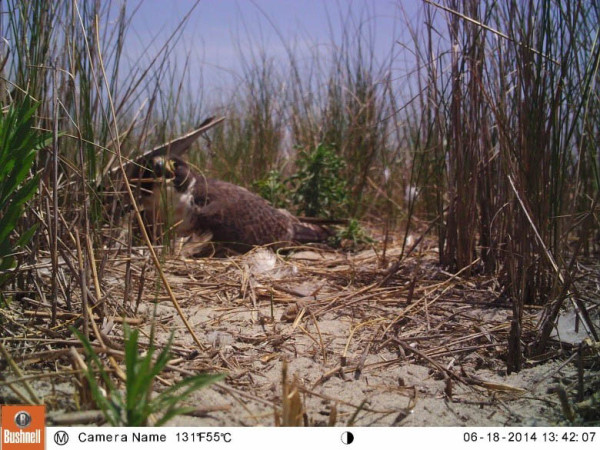
A ground nesting falcon on Cedar Island broods 2 chicks shortly before nest failure from extreme summer temperatures. Photo by CCB.
Project Partners: The Virginia Department of Game and Inland Fisheries, National Aeronautics and Space Administration, National Park Service, United States Fish and Wildlife Service, Virginia Department of Transportation, The Nature Conservancy, Dominion Power, and United States Coast Guard.
Written by Libby Mojica
January 13, 2015
Learn More:
Virginia peregrine falcon population management project



